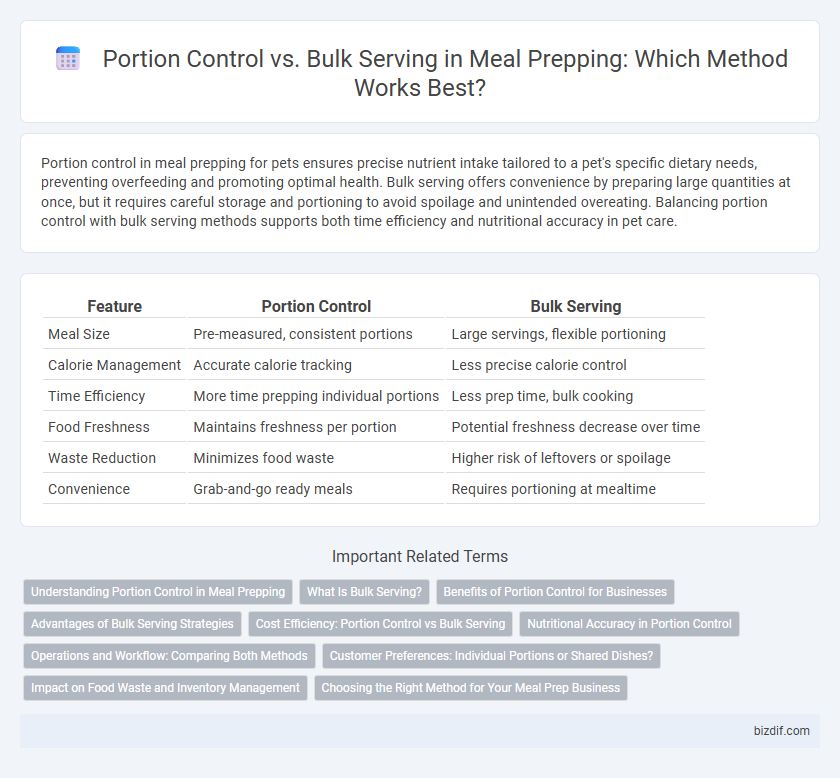Portion control in meal prepping for pets ensures precise nutrient intake tailored to a pet's specific dietary needs, preventing overfeeding and promoting optimal health. Bulk serving offers convenience by preparing large quantities at once, but it requires careful storage and portioning to avoid spoilage and unintended overeating. Balancing portion control with bulk serving methods supports both time efficiency and nutritional accuracy in pet care.
Table of Comparison
| Feature | Portion Control | Bulk Serving |
|---|---|---|
| Meal Size | Pre-measured, consistent portions | Large servings, flexible portioning |
| Calorie Management | Accurate calorie tracking | Less precise calorie control |
| Time Efficiency | More time prepping individual portions | Less prep time, bulk cooking |
| Food Freshness | Maintains freshness per portion | Potential freshness decrease over time |
| Waste Reduction | Minimizes food waste | Higher risk of leftovers or spoilage |
| Convenience | Grab-and-go ready meals | Requires portioning at mealtime |
Understanding Portion Control in Meal Prepping
Understanding portion control in meal prepping involves measuring and dividing meals into predefined serving sizes to maintain balanced nutrition and avoid overeating. Using tools like food scales, measuring cups, and portioned containers ensures consistent calorie intake and supports weight management goals. Portion control also aids in tracking macronutrients accurately, making it essential for tailored meal plans and dietary adherence.
What Is Bulk Serving?
Bulk serving refers to preparing large quantities of meals at once, allowing for easy storage and quick reheating throughout the week. This method saves time and reduces daily cooking efforts while promoting consistency in dietary habits. Bulk serving is ideal for managing calorie intake by dividing meals into pre-measured portions for balanced nutrition.
Benefits of Portion Control for Businesses
Portion control in meal prepping enhances inventory management by reducing food waste and optimizing ingredient usage, directly lowering operational costs for businesses. Consistent portion sizes improve customer satisfaction through reliable meal experiences, encouraging repeat orders and brand loyalty. Implementing portion control also streamlines kitchen workflows, increasing efficiency and enabling better cost forecasting for large-scale food service operations.
Advantages of Bulk Serving Strategies
Bulk serving strategies in meal prepping reduce cooking time and minimize cleanup by preparing larger quantities at once. This method promotes consistent portion sizes stored for future meals, enhancing convenience and reducing food waste. Storing bulk meals in airtight containers preserves freshness and nutrient content, supporting long-term meal planning efficiency.
Cost Efficiency: Portion Control vs Bulk Serving
Portion control minimizes food waste and reduces overall grocery expenses by allowing precise measurement of servings tailored to individual needs. Bulk serving offers cost savings through buying ingredients in larger quantities, but may result in higher waste if portions are not consumed fully. Analyzing meal consumption patterns helps determine whether portion control or bulk serving delivers greater cost efficiency for a household.
Nutritional Accuracy in Portion Control
Portion control enhances nutritional accuracy by allowing precise measurement of macronutrients and calories in each meal, ensuring dietary goals are consistently met. Bulk serving often leads to estimation errors and overconsumption due to lack of individualized portioning. Accurate portioning supports weight management and balanced nutrient intake, making it essential for effective meal prepping.
Operations and Workflow: Comparing Both Methods
Portion control streamlines meal prep with pre-measured servings, reducing waste and ensuring consistent calorie intake, which enhances operational efficiency and simplifies inventory management. Bulk serving requires larger storage containers and increased refrigeration capacity but accelerates prep time and allows for flexible portion adjustments during distribution. Workflow efficiency depends on kitchen size, staff availability, and storage resources, with portion control favoring precision and bulk serving emphasizing speed and adaptability.
Customer Preferences: Individual Portions or Shared Dishes?
Customers valuing portion control often prefer individual meal prep containers that enhance calorie tracking and reduce food waste, aligning with personal dietary goals. Conversely, those favoring bulk serving opt for shared dishes that support family-style eating and flexibility in meal customization. Understanding these preferences helps meal prep services tailor offerings to either promote convenience and precision or communal dining experiences.
Impact on Food Waste and Inventory Management
Portion control enhances inventory management by allowing precise measurement of ingredients, which reduces excess use and limits food waste in meal prepping. Bulk serving often leads to over-preparation, increasing the likelihood of leftovers that may spoil and contribute to higher food waste. Efficient portioning strategies support sustainable meal prep by optimizing ingredient usage and minimizing inventory discrepancies.
Choosing the Right Method for Your Meal Prep Business
Portion control enhances consistency and accuracy in meal prep businesses, ensuring each serving meets nutritional and calorie standards, which appeals to health-conscious customers. Bulk serving saves time and reduces packaging costs, ideal for clients who prefer flexible meal sizes or family-style dining. Selecting the right method depends on your target market's preferences, operational capacity, and pricing strategy to maximize efficiency and customer satisfaction.
Portion Control vs Bulk Serving Infographic

 bizdif.com
bizdif.com